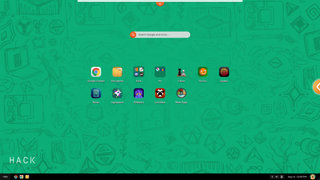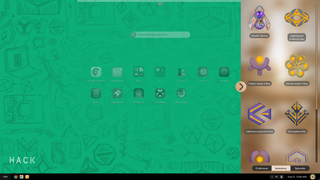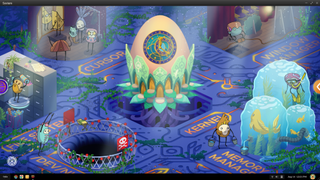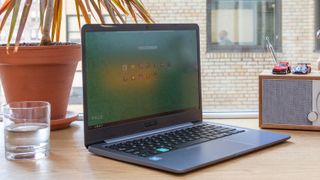Tom's Hardware Verdict
The Hack laptop attempts to teach kids how to code through fun, interactive games. Unfortunately, the limited content is more frustrating than fun, making this an expensive and uninteresting way to learn the basics of coding.
Pros
- +
Solid hardware
- +
Cute idea
Cons
- -
Poorly-designed lessons
- -
Limited content
Why you can trust Tom's Hardware
The Hack Laptop offers a unique way for kids ages 8 and up to learn how to code. Priced at $299, this 14-inch Asus E406MA laptop comes with Pentium Silver processor, 4GB of DDR4 RAM, 64GB of storage and runs Endless OS, a user friendly, Linux-based operating system. But the selling point is not the hardware or the OS, but the company’s custom learning software. The Hack claims to be the world’s only completely hackable computer made exclusively so that kids can learn the basics of coding. Hack also sells a USB Hack Key for $39.99, which allows you to download the Hack software onto any Windows computer so you don’t have to buy the laptop. Unfortunately, while the idea behind the device and software is excellent, the execution behind it falls way short.
In some ways, I am the ideal audience for this product. No, I am not a preteen. But I am a woman who is far too intimidated by the mention of loops and boolean logic to venture into her college’s computer science 101 class. I realize that I am never going to be a computer science major, but I would like to have a minimal idea of the logic behind computers, programs and how they function.
Instead of a class, I am much more interested in learning some basic coding concepts in a fun, relaxed environment. Also, I grew up on video games and am a sucker for gamified learning. The Hack computer sounds like a perfect way for me, or anyone, to have fun and gain some skills at the same time.
Design







The Hack’s Asus E406MA laptop is sleek, slender, and slight. At 2.8 pounds, the computer sits comfortably on the lap. Because it runs Endless Linux and performance is beside the point, we were unable to run any of our usual performance or battery benchmarks. However, we wouldn’t expect blazing speeds should you install your own OS and try to run productivity software on its Pentium Silver CPU. But just in case you want to plug in peripherals, there are two Type-A USB 3.0 ports, an HDMI port, a 3.5 mm headphone jack and a micro SD card slot.
The 14-inch full HD display covers 63.9% of the sRGB color gamut and averages 217 nits of brightness. This is completely adequate for going through the Hack programming, but has poor viewing angles, especially at a distance, making it not the best choice for video streaming.
The keyboard offers 1.3mm of key travel and 80 grams of actuation force, which makes for a pleasant typing experience. Although, I did find the plastic on the keyboard to be a little slippery and found my fingers accidentally moving to the wrong keys during long bursts of typing. The 4.0 x 2.8 inch trackpad is very responsive.
Specifications
| CPU | Intel Pentium Silver |
| Graphics | Intel UHD 605 (integrated) |
| Memory | 4GB DDR4 |
| SSD | 64 GB |
| Display | 14-inch 1920x1080 |
| Networking | Integrated 802.11ac Integrated 802.11b/g/n |
| Video Ports | HDMI 1.4 |
| USB Ports | 2x USB 3.1 Gen 1 Type-A |
| Audio | 2x Asus Sonic Master |
| Camera | None |
| Battery | 56Wh |
| Power Adapter | 50/60W universal |
| Operating System | Endless OS |
| Dimensions (WxDxH) | 326.4 x 226.5 x 15.8 mm |
| Weight | 2.8 pounds / 1.3 kg |
| Price (as configured) | $299 |
Operating System and UI
Instead of running Windows, the Hack makes use of Endless Linux, a flavor of Linux with a very simplified UI that’s easy for kids to understand. The OS is incredibly user friendly. The desktop consists of a Google search bar at the top of the screen, followed by a row of apps.
The Hack comes preloaded with Google Chrome; a chess game; a tools folder that includes a calculator; Gedit, a text editor; LibreOffice Writer, a word processor; and an encyclopedia. There is also an app store where you can download additional games, programs and multimedia.

On the far right of the screen is an arrow surrounded by a pulsating orange glow. This button opens a side panel into the "Clubhouse," where users are greeted by characters that lead them through the various missions. This feature is part of the Hack software and is not native to Endless Linux.
Hack Software
The heart of the entire system lies in Hack’s exclusive software. Access to this is found right away in the Clubhouse. Clicking on the character Ada immediately starts a text box which leads to the beginning of the missions, each of which involve “hacking” different games by performing simple coding tasks. As you advance through the story line, different characters appear to tell you what changes to make in the games and give you hints and clues.
Tabs at the bottom of the Clubhouse show the inventory of the items you’ve collected from your missions, as well as the episodes -- different lesson modules -- and your progress. As of now, there are only four episodes, though the Hack promises to release one a month. Users get the first six months of content for free. Hack charges $9.99 a month for further access to new content after the trial expires.

The lessons themselves are supposed to offer kids ages 8 and up a fun way to learn the basics of computers and coding. All the games have a blue button on the left side of the screen which "flips" to the back end of the program so you can “hack” the code to change settings.
This sounds like fun and sometimes it is, but there’s way too much frustration.The flow of the lessons and the introduction to the characters and programs feels disjointed. Some of the computer programs on the system use the Hack feature -- the one where you flip to code mode -- more than others. The ones that don’t take advantage of this feel totally pointless.
For example, users are quickly introduced to Ada before being shuttled along to a program on the desktop called the “Roster,” which offers little more than character profiles that are about as interesting and interactive as a generic "create-a-character" PDF.
There is little use of the Hack feature, but plenty of useless information. The Roster explains that Ada’s favorite foods are artichokes, romanesco broccoli, pomegranates and pineapples, but there is no relevance to this information whatsoever. It is never incorporated into the game in any way. Aside from a quick lesson on changing colors and fonts, there is absolutely no reason to touch the Roster at all.
The same can be said of the “System” program. Do not be fooled into thinking that the app sitting nicely on the desktop will let you adjust the laptop’s system settings. Instead, you get a somewhat confusing overview of what various parts of a computer do. Clicking on System icon will instead plunge you into a blue room centered by a giant egg-shaped structure with ticking clock. Using the mouse to hover over a structure reveals that this is the "Kernel."

The Kernel is surrounded by other structures including a file cabinet (the file system), a black hole (/dev/null), a small aquarium (memory manager), a little creature holding two plugs (window manager), and another creature looking at itself in a mirror while wearing a cheese suite (daemon).
Clicking on the Kernel unveils a long, overly -ritten and fairly technical explanation of what the Kernel of a computer is and how it works. Unfortunately, I think that egg is actually supposed to be a nut, since the text from Ada claims that “we can think of the operating system as a seed or a nut, a concentration of information to generate growth.”
Or maybe the dome-like structure is really an air traffic controller, as another character writes that "you could say the Kernel acts like an air traffic controller. The Kernel’s job is to interface between the programs and the hardware. The memory is just the hardware. It’s keeping track. It can swap out what different programs use by allocating some it to physical memory."
No matter what this structure is supposed to be, I found the explanations confusing and I can’t imagine a younger child understanding or caring about these definitions. In fact, it is not clear exactly what you are supposed to be clicking on, as the little daemon characters are the only objects in motion and therefore the only things that really catch your eye. Overall, the System program is a sloppy and unimaginative way of introducing concepts that, though interesting, seem to bear no relation to the rest of the content.
The bulk of the challenges throughout the four episodes currently available take place in three games: Fizzics, Lightspeed, and Sidetrack.






Fizzics, as its name implies, is a puzzle game where you can adjust settings of attraction/repulsion, friction, radius, bounce and gravity to help you slingshot an orange ball around obstacles in order to put it in a goal. The challenges are appropriately difficult, but numerous and repetitive. The hints given by the characters were helpful, though I don’t think I needed 22 levels to understand the concepts the game was teaching me. For example, there were many levels where I needed to adjust the positive and negative attractions of different balls in order to solve the puzzle. The idea is to have the orange ball and the goal stick together like magnets. This was challenging for the first few times, but became monotonous when I was continually asked to perform variations of the same task level after level.
Lightspeed, on the other hand, was by far the most challenging part of the entire Hack process. Ostensibly, the game is simple: collect 10 astronauts while avoiding space debris. Yet the challenges in Lightspeed have more to do with actual coding than collecting astronauts.
Here, we are taught function and if statements, how to position objects on the screen, and how to create new objects and direct their action. Unfortunately, the instructions given by the characters are not always clear and sometimes I was typing in the answers without knowing exactly what I was doing or why. This became particularly frustrating when I was asked to remember how to do something from a previous challenge, even though I had no idea what it was that I had actually done.
To make matters worse, there is no way to go back to a previous challenge without resetting your entire progress, so if you get stuck, there is no way to get a hint if the topic being covered was from a different level. I found this completely demoralizing.

Part of the problem lies in the fact that the code isn’t standard, though the syntax appears to be JavaScript. Lightspeed responds to some Javascript prompts, but not others, so even a parent who is familiar with the language could not help a stuck child without going through all the challenges with them. More importantly, since you’re not learning standard coding, the skills aren’t completely transferable to another environment.
Despite the fact that I am surrounded by computer professionals well-versed in Javascript, no one was able to help me with the code I was stuck on. I had to reset the entire game and play through it again to relearn the piece of code that I forgot. Finally getting past the level was rewarding, but it was incredibly frustrating to have to start over from the very beginning.
Hoping for a better experience in the fourth episode, I was sorely disappointed. Sidetrack, the game introduced in this episode, is a typical maze-like puzzle. The object is to get a character around obstacles from one end of the maze to the other. The coding – consisting entirely of writing a list of moves for a character – is incredibly easy, especially compared to Lightspeed. I didn’t feel as if I learned much of anything as I slogged through 40 tedious, monotonous levels. Completing all of the episodes felt less like a triumph and more like a relief.
I would like to say that at least the programs themselves ran smoothly, but that was just not the case. Often, a program would freeze or a character would not register my progress. This lead to numerous restarts and shutdowns. Part of the problem seemed to come from the fact that the computer programs did not close when you leave them. Often, a character tells you to go back to the clubhouse and immediately launch another program. The new program opens right over the old one, while the characters from the clubhouse continue with the latest mission. It is easy to have multiple programs running at once without realizing it. In fact, the charters tell you to open programs, but never to close them. This seems to tax the 4GB of RAM on the Asus, especially when three or four programs are running at the same time.
Parental Controls or Lack Thereof
The Hack is first and foremost a kid-friendly laptop. It’s strange then, that the standard account on the computer comes with unfettered internet access through Google Chrome and no built-in parental control software. The good news is that the entire Hack program does not rely on the internet at all and can be played without a connection. However, there is no way to prevent users from turning on Wi-Fi to access the internet, even if they began using the program without it.

Bottom Line
The Hack computer is a good idea, poorly executed. For those looking for a more wide-ranging STEM learning toy, the Kano Computer Kit Touch is a much better option that includes a lot more learning software that is well-written and helpful. For example, instead of the confusing “system” app on the Hack, the Kano has a fun, interactive game where you guide a character around the inside of the computer and learn that way. And the Kano also has you build it from parts which adds to the learning experience.
The fundamental idea behind Hack is a great one: gamify STEM learning by having kids modify the code of games. However, the lesson flow is confusing and there’s too much focus on being cute -- for example, reading about the fictional character’s love of artichokes -- and not enough on teaching transferable coding skills. And, once you get through a lesson, the computer offers no outlet to use those skills independently nor is the code you learn sufficient for someone to start writing their own code in adult programming languages.
Perhaps future software updates will make the Hack software more compelling. But, as of now, we can’t recommend it.
Photo Credits: Tom's Hardware
MORE: Best Gaming Laptops
MORE: Laptop Reviews
MORE: All Laptop Content
